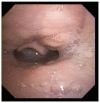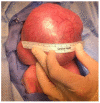Neonatal Airway Abnormalities
- PMID: 35883928
- PMCID: PMC9322467
- DOI: 10.3390/children9070944
Neonatal Airway Abnormalities
Abstract
Neonatal airway abnormalities are commonly encountered by the neonatologist, general pediatrician, maternal fetal medicine specialist, and otolaryngologist. This review article discusses common and rare anomalies that may be encountered, along with discussion of embryology, workup, and treatment. This article aims to provide a broad overview of neonatal airway anomalies to arm those caring for these children with a broad differential diagnosis and basic knowledge of how to manage basic and complex presentations.
Keywords: airway obstruction; congenital neck mass; larynx; neonate; respiratory tract; surgery; trachea.
Conflict of interest statement
The authors declare no conflict of interest.
Figures










References
-
- Klinginsmith M., Goldman J. StatPearls. StatPearls Publishing; Treasure Island, FL, USA: 2022. Laryngomalacia. - PubMed
Publication types
LinkOut - more resources
Full Text Sources

